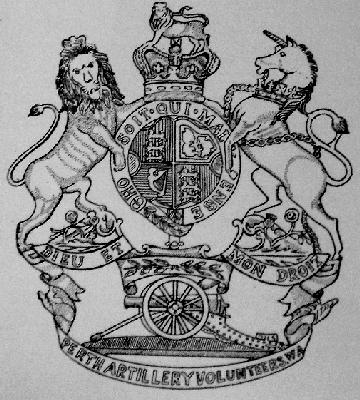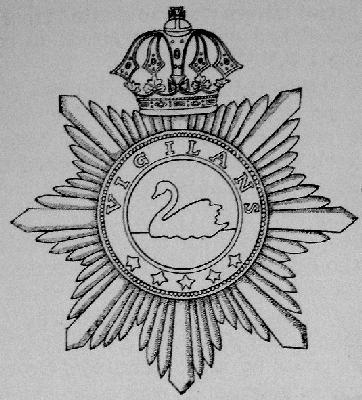Topic: Militia - LHW - WA
Western Australian Militia
Uniforms and Badges
The following is an extract from the book written in 1962 by George F. Wieck called The Volunteer Movement in Western Australia 1861-1903, pp. 78 - 82:
Uniforms and Badges
Uniforms
Detailed descriptions of uniform adopted by the early Volunteer Infantry corps do not exist therefore the descriptions given herein are incomplete and possibly inexact in some cases. The best has been done with the information available.
Records indicate that about the year 189 the tunic worn by British Infantry was changed to a pattern described by the press of the day as long, ill-fitting, loose and slovenly. Presumably that was the pattern adopted by the Perth and Fremantle Volunteer Rifles in 1862, for the Illustrated London News in 1864 reproduced a sketch drawn by Captain E. Henderson, R.E., depicting these two corps parading in front of Government House, Perth, on a ceremonial occasion, wearing long scarlet tunics, white duck (or canvas) trousers, and shakoes. There is ground for the belief that the Perth facings were blue and Fremantle's green.
The Pinjarrah and Wellington mounted corps adopted a uniform stated to be a replica of that of the 6th Dragoon Guards (with white cords instead of yellow), i.e. scarlet tunic, white doe-skin pantaloons, white helmet with spike, and over-boots. A brief reference to the Union Troop suggests its uniform was of Hussar type.
The W.A. Troop of Horse Artillery appears to have worn a uniform which was for all practical purposes a replica of that of the British Horse Artillery. The Naval Artillery Volunteers carried on Naval tradition.
In 1872 the newly formed Perth and Fremantle infantry adopted in each case, the uniform worn by its predecessor.
New Corps were formed but the first inkling of uniform and details is gained from a ‘water-colour' executed by Lieutenant Colonel E. F. Angelo, Military Commandant at the Albion camp in 1884 which depicts the whole of the Infantry Volunteers (excepting the Geraldton Corps) on a ceremonial parade wearing scarlet tunic, blue trousers and white helmet. It is not known when helmets were officially adopted but there exists a photograph taken in 1878 of soldiers some wearing white helmets and others blue or dark green.
Dress Regulations for Volunteers were promulgated in 1888 (Government Gazette. No. 55) prescribing what should be worn by Officers of Artillery and Infantry (there was no Cavalry at that time). British Army patterns were closely followed, the artillery volunteers copying the Royal Artillery and the infantry adopting the normal scarlet tunic (now shortened), blue trousers with scarlet seam (plus silver braid for ceremonial occasions) and helmet. Infantry could choose a helmet of either dark green British Army pattern or one of the white Mediterranean type; for facing colours they could choose from blue, green, white or yellow. Perth Rifle Volunteers chose blue for facings, all others it is understood originally adopted green; at a later date three corps at least, i.e. Perth, Albany and Bunbury, changed to white.
The 1888 Regulations also authorised blue undress uniform, khaki being substituted by the end of the century.
The year 1900 saw several major divergences.
The West Australian Mounted Infantry adopted khaki tunic, light coloured breeches, slouch hat (turned up on right side) and ‘concertina' top-boots. The Metropolitan Civil Service Battalion favoured grey tunic and trousers, black helmet and black facings. The Goldfields Battalion of Infantry adopted a workmanlike khaki with puttees and slouch hat. The West Australian Highlanders proudly wore a replica of the uniform of the 79th Cameron Highlanders, including the Erract tartan.
Badges
As in the case of uniform, there is no recorded description of the design and date of adoption of the various corps badges. Several helmet plates dating chiefly from the `eighties' have been located; comparison of these suggests the adoption of two basic designs, one for artillery, the other for infantry. The following sketches are copies from the plates of the Perth Artillery Volunteers and Perth Rifle Volunteers respectively. The basic designs were amended to meet the requirements of each corps as follows:
Perth Artillery Volunteers Badge
Artillery (1): The words Perth, Fremantle, or Albany being inserted according to requirements. The Albany Corps' plate included a fortress type gun on a barbette mounting in lieu of the field gun.
Fremantle Rifle Volunteers BadgeInfantry (2) : The Fremantle Rifle Volunteers plate had a circular strap almost entirely enclosed by a laurel wreath, super-imposed upon the basic star and crown; the area within the strap carried the conventional bugle with ribbons attached and in raised letters on the strap was the Corps title – “Fremantle Rifle Volunteers: Western Australia.”
The Guildford Rifle Volunteers plate had the laurel wreath and a raised "circle" instead of a strap, on the circle in raised letters was the motto "Honi Soit Qui Mal y Pense" and within the circle, in script the Corps initials G.R.V.
The Geraldton Rifle Volunteers plate carried the Corps title on the raised circle with bugle and ribbons within as in the case of Fremantle. It is believed that Albany, York and Bunbury also adopted this style.
There were two unconventional types.
The Civil Service Rifle Volunteer Corps adopted a black oxidized Maltese Cross with an interior raised circle carrying the Corps title. Within the circle on a solid background was a representation in white metal of the crest of the Prince of Wales.
The Goldfields Infantry Regiment's plate was a white metal "Rising Sun" surmounted by a St. Edmund's Crown. In the centre on a solid ground, was an enamelled black swan and on a 3-section (2 over 1) scroll below in raised letters the corps title appeared.
Previous: Organization and Training
Next: Western Australian Militia, Light Horse
Further Reading:
Western Australian Militia, Light HorseWestern Australian Militia, Infantry
Citation: The Volunteer Movement in Western Australia, Uniforms and Badges





